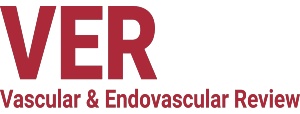|
Published online: Copyright Statement:
This work is open access under the CC-BY-NC 4.0 License which allows users to copy, redistribute and make derivative works for non-commercial purposes, provided the original work is cited correctly.
|
The treatment of vascular disease continues to advance at a rapid pace. Treatment has moved on from standard open procedures with a number of new technologies challenging old dogmas. In this context, it is vital for vascular practitioners to have ready access to information to help guide their thinking. New techniques require critical appraisal to ensure that they are implemented appropriately, and practitioners need regular updates to help keep them informed. The constant struggle between what’s new and the gaps in evidence, as well as striving to maintain appropriate care, will always be paramount.
Vascular & Endovascular Review (VER) aims to provide vascular interventionists – whether they be interventional radiologists, angiologists, vascular physicians, cardiologists or vascular surgeons – educational and informative material as a resource to keep their practice up to date. The journal provides a comprehensive update on a range of pertinent issues to support vascular interventionists to continuously develop their knowledge and effectiveness in day-to-day clinical practice.
This first issue comprises a range of reviews and case studies focused on current topical issues in vascular and endovascular surgery. There are three articles on peripheral artery disease. Fabrizio Fanelli and Alessandro Cannavale discuss drug-coated balloons as an important innovation and established technique in the treatment of atherosclerotic disease of the femoropopliteal region. Emad Hussein looks at stem cell therapy for vascular disorders, and proposes that stem cell-based regeneration of the endothelium may be a promising approach for treating peripheral artery disease. In their review, Omar Jawaid and Ehrin Armstrong discuss the endovascular treatment of common femoral artery atherosclerotic disease, and summarise the current data regarding acute and long-term outcomes for endovascular treatment of common femoral artery disease.
We also have an article by Wee et al. on carotid access for aortic interventions, as well as an article by Choong et al. on computation fluid dynamics and aortic dissections, in which the authors review the methodology, benefits as well as obstacles associated with computation flow dynamics in the field of vascular surgery. In their case report, Gallardo Pedrajas et al. discuss acute renal failure 4 months after endovascular aneurysm repair and bilateral renal arteries parallel stenting “chimney technique” (CH-EVAR), and compare renal artery geometry before and after CH-EVAR to find a possible cause of stent thrombosis.
Amato et al. discuss advances in surgical techniques improving outcomes in varicose vein treatment. In their article, they determine whether the use of laser and different parameters influenced morbidity rates and learning curves for all technology improvements during the study period, and found that negatives outcomes diminished with the adoption of new strategies and skills, and Sivakumaran et al. provide a case report on an ilio-iliac arteriovenous fistula following spontaneous rupture of a right common iliac aneurysm.
I am grateful to all those who have provided articles for this first edition and to the Board of Section Editors we have assembled for giving their time. The Editorial Team and Publisher hope you find this issue of VER valuable.
